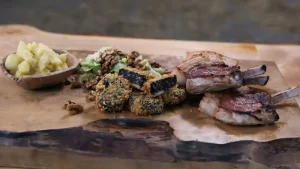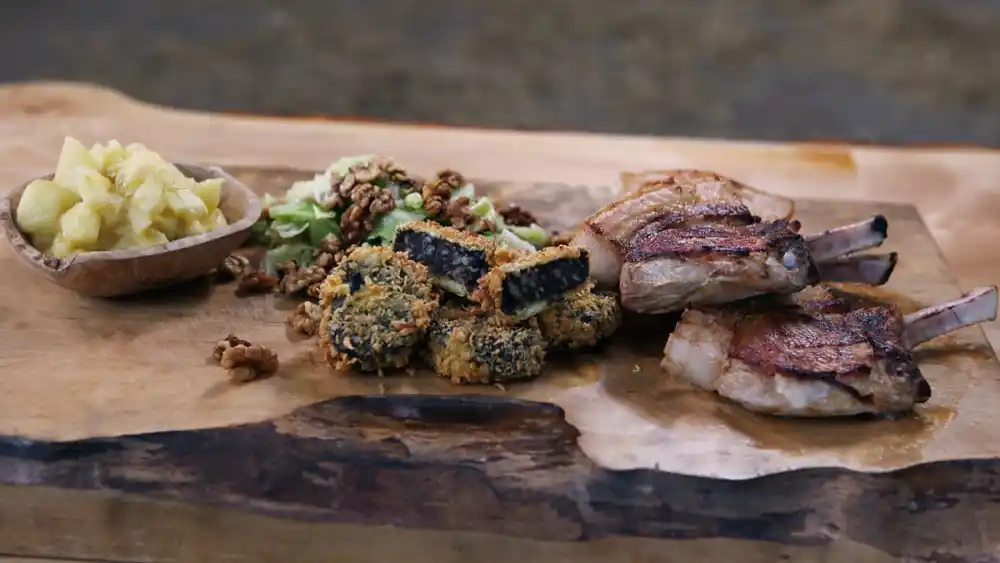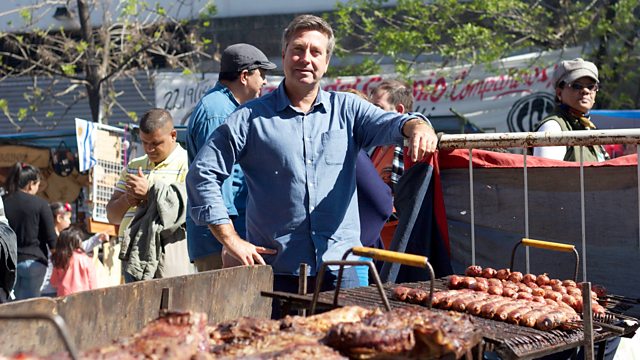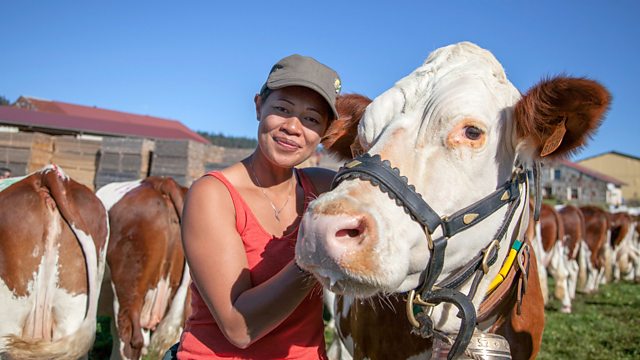James Martin’s Food Map of Britain episode 9 – Accomplished Chef James Martin embarks on an extraordinary adventure, taking to the skies to delve into the enchanting landscape of the British Isles. This remarkable journey lets him uncover the mysteries of how the land’s diverse and distinct geography fosters the growth of an array of regional ingredients, each bringing a unique and delightful taste to the table. James journeys over the lush, fertile plains of Lincolnshire and the sprawling flatlands. This region, steeped in agricultural tradition, is famous for its world-class pork. James is intrigued to uncover why this area has gained such a notable reputation. He discovers that the environment is ideally suited to raising robust and healthy pigs, resulting in pork that is renowned for its exceptional quality and taste.
In addition, Lincolnshire is also well-known for its impressive pea production. The flatlands, enriched with fertile soil and a favourable climate, offer an optimal environment for the growth of peas. The region’s ability to mass produce these perfect peas is a testament to the harmony between its agricultural practices and the natural environment. As James continues on his quest to explore the culinary treasures of the British Isles, he doesn’t just uncover the story behind these ingredients, but he also brings them to life through his exquisite cooking.
First, he celebrates Lincolnshire’s celebrated pork by cooking up succulent pork chops. To complement the meat’s rich flavours, he creates a scrumpy apple sauce, bringing a sweet and tangy contrast. To add an element of crunch, he pairs this with crispy cabbage, balancing the succulent pork with its vibrant freshness.
Then, turning his attention to the peas, James cooks a fillet of plaice, a dish that showcases the verdant peas in their full glory. He serves the steamed fillet with a smooth pea puree, the colour of which mirrors the rolling fields he explored earlier. Not content with just the puree, he also includes whole steamed peas in their pods, adding a delightful texture. To round out this dish, he adds asparagus spears and crispy bacon, the latter adding a salty contrast to the sweetness of the peas and the delicate fish. In both dishes, James effortlessly combines local ingredients to create meals that tell a story – a story of the land, its produce, and the culinary delights that can be crafted from them.
James Martin’s Food Map of Britain episode 9
Plaice with pea purée, bacon, new potatoes and asparagus

Indulge in a nutritious and scrumptious meal that effortlessly combines the delicate flavors of steamed fish with the vibrant crunch of freshly prepared vegetables. Every bite of this wholesome dish promises not only to satisfy your taste buds, but also nourish your body, taking you on a gastronomical journey that harmoniously balances health and taste. This delightful medley of steamed fish and vegetables is nothing short of a culinary masterpiece, perfectly crafted to bring you the very best of a hearty, healthy, and delicious meal.
Ingredients
- 3 whole plaice, filleted and skinned (or 12 fillets of plaice)
- 8 rashers smoked dry-cured streaky bacon
- 200g/7oz baby new potatoes
- 1 bunch asparagus
- handful peas in their pods
- 20g/1oz unsalted butter, softened for greasing
- pea shoots, to garnish
- rapeseed oil, for dressing pea shoots
For the pea purée
- 50g/1¾oz unsalted butter
- 200g/7oz fresh podded peas
- small handful flatleaf parsley
- 100ml/3½fl oz double cream
- salt and freshly ground black pepper
Method
- Roll up each of the 12 plaice fillets and set aside.
- Fry the bacon rashers in a dry pan until crisp. Drain on kitchen paper.
- For the pea purée, add the butter to the pan used to cooked the bacon. Heat until melted, then add the peas, parsley, 50ml/2fl oz water and double cream. Season to taste with salt and pepper. Warm through on a gentle heat and then transfer to a blender and pulse until you have a very smooth purée. Taste to check the seasoning and add more butter if desired.
- Put the new potatoes into the lower basket of a two-tier bamboo steamer set over a pan of boiling water. Steam for seven minutes.
- Meanwhile, cut out a circle of greaseproof paper to line the top basket of the bamboo steamer. Grease the paper with a little butter and line the basket of the bamboo steamer with it. Season the rolls of plaice with salt and pepper and place them on the paper.
- When the potatoes have been cooking for seven minutes, add to them the asparagus and peas in their pods and steam for a further 2-3 minutes or until tender.
- Place the top basket containing the plaice on top of the vegetables and cook for 2-3 minutes, or until cooked through (take care not to overcook them).
- To serve, toss the pea shoots in a little rapeseed oil and divide the plaice fillets between four serving plates. Add some pea purée, crisp bacon and steamed vegetables. Garnish with the dressed pea shoots.
Pork loin with scrumpy sauce, candied walnuts and cabbage

Step into a world of culinary innovation with this unique recipe. This isn’t your typical pork loin dish; instead, it’s a delectable combination of ingredients that will show you a whole new side of what pork chops can be. Each ingredient carefully complements the others, resulting in a dish that’s far from ordinary.The centerpiece, a perfectly prepared loin of pork, forms the foundation of this recipe. Its succulent nature is beautifully paired with a scrumpy sauce that adds a twist of tanginess, elevating the simple loin into a dish worthy of any weekend gathering or special occasion.
Then, to balance the savory flavors, candied walnuts are incorporated. These sweetened morsels bring an unexpected yet delightful sweetness to the dish, providing a pleasing contrast to the savoury sauce. Crisp black pudding makes its entrance next, offering a crunch that juxtaposes the softness of the pork. This ingenious addition serves to show how black pudding, often relegated to the breakfast table, can find a place in more sophisticated culinary creations.
Finally, the hispi cabbage ties it all together. Its fresh and mild flavor is a perfect companion to the boldness of the other ingredients, completing the dish in a symphony of contrasting tastes and textures. With this recipe, you can transform your perception of pork chops, showcasing them not just as a weekday staple, but as a delicacy that has the potential to be a showstopper at any meal. Experience the magic of this extraordinary recipe that is destined to turn the ordinary into something truly special. This is more than just a meal, it’s a culinary revelation.
Ingredients
For the scrumpy sauce
- 25g/1oz unsalted butter
- 4 bramley apples, peeled and cut into chunks
- 50g/1¾oz caster sugar
- 200ml/7fl oz scrumpy cider
For the candied walnuts
- 100g/3½oz caster sugar
- 100g/3½oz walnut halves
- rapeseed oil, for shallow frying
For the crisp black pudding
- 200g/7oz black pudding
- 50g/1¾oz plain flour
- 2 free-range eggs, beaten
- 50g/1¾oz panko breadcrumbs
- rapeseed oil, for deep frying
For the pork
- 1 kg/2lb 4oz bone-in pork loin, French trimmed, cut into four thick chops
salt and freshly ground black pepper - For the hispi cabbage
- 25g/1oz unsalted butter
- 1 hispi cabbage, sliced thickly
- salt and freshly ground black pepper
Discovering the Culinary Landscape with James Martin’s Food Map of Britain
A Journey Begins with a Single Bite
Imagine embarking on a gastronomic journey, a culinary exploration that takes you through the verdant valleys, the rugged coastlines, and the quaint villages of the British Isles. This is the adventure that renowned chef James Martin invites us to join in his captivating series, “James Martin’s Food Map of Britain”.
As we traverse this delicious landscape, we encounter regional ingredients that are as diverse and unique as the locales they hail from. Each bite is a revelation, a story of tradition and innovation that unfolds on our taste buds. This is not just about food; it’s about the people, the culture, and the history that have shaped these culinary treasures.
The Man Behind the Map: James Martin
James Martin, a name synonymous with British cuisine, is our guide on this epicurean expedition. Known for his affable charm and culinary prowess, Martin has been a beloved figure in the world of food for decades. His passion for regional ingredients and traditional recipes is infectious, making him the perfect companion for this journey.
Martin’s approach to cooking is a testament to his love for the British Isles. He believes in the power of simplicity, letting the quality of ingredients shine through. His recipes are a celebration of the land and its bounty, a tribute to the farmers, fishermen, and artisans who are the unsung heroes of our food story.
The Food Map: A Tapestry of Flavours
“James Martin’s Food Map of Britain” is a culinary tapestry, woven with the flavours of the British Isles. Each episode takes us to a different region, uncovering the local ingredients and recipes that define its food culture.
In the verdant pastures of Wales, we discover the succulent Welsh lamb, a regional ingredient that has been a staple of Welsh cuisine for centuries. In the coastal towns of Cornwall, we delve into the world of seafood, tasting the freshest catch of the day. And in the bustling markets of London, we explore the melting pot of flavours that make up the city’s vibrant food scene.
The Power of Regional Ingredients
The star of this food map is undoubtedly the regional ingredients. These are the building blocks of our culinary heritage, each one carrying a piece of our history and culture. They are the heart and soul of our recipes, the essence of our food.
Take the humble potato, for example. In the hands of a skilled chef like Martin, this simple ingredient transforms into a dish that is comforting and familiar, yet exciting and new. It’s a testament to the power of regional ingredients, a reminder that great food doesn’t have to be complicated.
The Recipes: A Celebration of Tradition and Innovation
The recipes featured in “James Martin’s Food Map of Britain” are a blend of tradition and innovation. They pay homage to the classics, while also pushing the boundaries of what British food can be.
From the hearty stews of the North to the delicate pastries of the South, these recipes showcase the diversity of British cuisine. They are a testament to the creativity and resilience of our food culture, a celebration of our culinary journey.
The Emotional Connection: Food as a Storyteller
Food is more than just sustenance; it’s a storyteller. Each dish is a narrative, a tale of the people and places that have shaped it. This is the emotional connection that “James Martin’s Food Map of Britain” seeks to foster.
As we journey through this food map, we are not just tasting food; we are tasting stories. We are experiencing the love, the passion, and the dedication that go into every dish. And in doing so, we are forging a deeper connection with the land and its people. As we delve into Martin’s recipes, we are not just learning to cook; we are learning to tell stories. Each recipe is a narrative, a tale of the people and places that have shaped it. This is the emotional connection that “James Martin’s Food Map of Britain” seeks to foster.
Take, for example, the humble spud. In the hands of a skilled chef like Martin, this simple ingredient transforms into a dish that is comforting and familiar, yet exciting and new. It’s a testament to the power of regional ingredients, a reminder that great food doesn’t have to be complicated.
Conclusion: Mapping Our Culinary Heritage
“James Martin’s Food Map of Britain” is more than just a TV show; it’s a celebration of our culinary heritage. It’s a journey through the flavours of the British Isles, a tribute to the regional ingredients and traditional recipes that define our food culture.
As we traverse this delicious landscape with Martin, we are reminded of the power of food. It’s not just about sustenance; it’s about connection. It’s about the stories we tell, the memories we create, and the traditions we pass on. And in doing so, we are forging a deeper connection with the land and its people.
So, let’s embark on this journey together. Let’s explore the Food Map of Britain and discover the culinary treasures that await us. Because every journey begins with a single bite, and every bite is a story waiting to be told.
FAQ:
1. What is “James Martin’s Food Map of Britain”?
- “James Martin’s Food Map of Britain” is a captivating series where acclaimed chef James Martin embarks on a gastronomic journey across the British Isles. Each episode explores a different region, delving into its unique culinary treasures, ingredients, and recipes that define its food culture. The show celebrates the diverse and distinct geography of Britain that influences its regional cuisines.
2. What does episode 9 of “James Martin’s Food Map of Britain” focus on?
- Episode 9 of “James Martin’s Food Map of Britain” takes viewers on a journey over the fertile plains of Lincolnshire, a region famous for its world-class pork and impressive pea production. The episode explores why this area, rich in agricultural tradition, has gained such a notable reputation and how the environment is ideally suited to raising robust and healthy pigs and growing peas.
3. What dishes does James Martin prepare in this episode?
- In this episode, James Martin celebrates the renowned Lincolnshire pork and peas by cooking up succulent pork chops with a scrumpy apple sauce, and crispy cabbage. Turning his attention to the peas, James cooks a fillet of plaice, served with a smooth pea puree, whole steamed peas, asparagus spears and crispy bacon.
4. Why does James Martin focus on regional ingredients in his cooking?
- James Martin believes in the power of simplicity in cooking and lets the quality of regional ingredients shine through in his recipes. He views these ingredients as the building blocks of culinary heritage, each carrying a part of the region’s history and culture. By focusing on regional ingredients, he pays tribute to the farmers, fishermen, and artisans who contribute to the story of food.
5. What makes “James Martin’s Food Map of Britain” unique?
- “James Martin’s Food Map of Britain” is a culinary tapestry that celebrates the diversity of the British Isles. It offers viewers a unique perspective on the rich tapestry of regional British foods, spotlighting local ingredients and traditional recipes. With Martin’s expert guidance, the show offers a gastronomical journey that narrates the story of the land, its produce.




